Detection of Microstructural Changes in Metastable AISI 347, HSS Z-M4 and Tool Steel Ferrotitanit WFN by Mechanical Loss Coefficient at Ultrasonic Frequencies
Abstract
:1. Introduction
2. Materials and Methods
2.1. Materials
2.2. Modal Analysis
2.3. Very High Cycle Fatigue (VHCF) Experiments on AISI 347
2.4. Thermal Treatment of Sonotrode Materials
2.5. Determination of Young’s Moduli
3. Results and Discussion
4. Conclusions
- The determination of loss coefficient by FWHM-modal analysis was successfully used to notice changes in material properties for sonotrode materials (Z-M4 and WFN) by thermal treatment and in metastable austenitic stainless steel AISI 347 due to cyclic loading.
- Although the loss coefficient was inappropriate to mathematically explain the change in microstructure and properties, a large difference before and after thermal treatment was recognized.
- Changes in elastic moduli were identified to be most likely responsible for changes of the Eigenfrequency after thermal treatment of sonotrode materials, significantly simplifying future calculation and design of sonotrodes.
- Investigations on AISI 347 showed, that loss coefficients strongly correlated to the content of fatigue induced ferromagnetic α′-martensite and hence, indicate microstructural changes accurately. However, the expected decrease of the loss coefficient due to the formation of α′-martensite was not confirmed, but rather a domination by other possible microstructural changes that were also shown in previous studies.
- The hypothesis, that a determination of loss coefficients by non-destructive modal analysis, representing material changes, is suitable for quality control and process monitoring as the loss coefficient is very sensitive to small changes in materials and components, was confirmed.
Author Contributions
Funding
Institutional Review Board Statement
Informed Consent Statement
Data Availability Statement
Acknowledgments
Conflicts of Interest
References
- Liesegang, M.; Arweiler, S.; Beck, T.; Balle, F. Orbital Ultrasonic Welding of Ti-Fittings to CFRP-Tubes. J. Manuf. Mater. Process. 2021, 5, 30. [Google Scholar] [CrossRef]
- Liesegang, M.; Yu, Y.; Beck, T.; Balle, F. Sonotrodes for Ultrasonic Welding of Titanium/CFRP-Joints—Materials Selection and Design. J. Manuf. Mater. Process. 2021, 5, 61. [Google Scholar] [CrossRef]
- Giertler, A.; Krupp, U.; Michels, W. Correlation of the fatigue damage with the damping behavior of a cast aluminum alloy. Mater. Test. 2011, 53, 285–289. [Google Scholar] [CrossRef]
- Austenitic TRIP/TWIP Steels and Steel-Zirconia Composites; Biermann, H.; Aneziris, G.C. (Eds.) Springer International Publishing: Cham, Switzerland, 2020; ISBN 9783030426026. [Google Scholar]
- Ghorbanhosseini, S. A Review of the Failure and Damage Forms of Metals under Cyclic Loading. Int. J. Curr. Sci. Res. Rev. 2020, 3, 178–184. [Google Scholar] [CrossRef]
- Ahn, B.; Lee, S.S. Effect of microstructure of low carbon steels on ultrasonic attenuation. IEEE Trans. Ultrason. Ferroelectr. Freq. Control 2000, 47, 620–629. [Google Scholar] [CrossRef] [PubMed]
- Sha, G.; Huang, M.; Lowe, M.J.S.; Rokhlin, S.I. Attenuation and velocity of elastic waves in polycrystals with generally anisotropic grains: Analytic and numerical modeling. J. Acoust. Soc. Am. 2020, 147, 2442. [Google Scholar] [CrossRef]
- Hirao, M.; Ogi, H.; Suzuki, N.; Ohtani, T. Ultrasonic attenuation peak during fatigue of polycrystalline copper. Acta Mater. 2000, 48, 517–524. [Google Scholar] [CrossRef]
- Ogi, H.; Hamaguchi, T.; Hirao, M. Ultrasonic attenuation peak in steel and aluminum alloy during rotating bending fatigue. Met. Mat Trans A 2000, 31, 1121–1128. [Google Scholar] [CrossRef]
- Liesegang, M.; Beck, T. Ultrasonic welding of magnetic hybrid material systems –316L stainless steel to Ni/Cu/Ni-coated Nd2Fe14B magnets. Funct. Compos. Mater 2021, 2, 441. [Google Scholar] [CrossRef]
- CPM 10V: Datasheet; Zapp Materials Engineering GmbH: Ratingen, Germany, 2019.
- Z-M4 PM: Datasheet; Zapp Materials Engineering GmbH: Ratingen, Germany, 2019.
- Ferrotitanit: Datasheet; Deutsche Edelstahlwerke Specialty Steel GmbH & Co. KG.: Krefeld, Germany, 2020.
- Foller, M.; Meyer, H. A new investigation on mechanical properties of ferro-titanit. In Proceedings of the 6th International Tooling Conferece, Karlstad, Sweden, 10–13 September 2002; pp. 1373–1389. [Google Scholar] [CrossRef]
- Daniel, T.; Smaga, M.; Beck, T. Cyclic deformation behavior of metastable austenitic stainless steel AISI 347 in the VHCF regime at ambient temperature and 300 °C. Int. J. Fatigue 2022, 156, 106632. [Google Scholar] [CrossRef]
- Staab, F.; Liesegang, M.; Balle, F. Local shear strength distribution of ultrasonically welded hybrid Aluminium to CFRP joints. Compos. Struct. 2020, 248, 112481. [Google Scholar] [CrossRef]
- Talonen, J.; Hänninen, H. Damping properties of austenitic stainless steels containing strain-induced martensite. Met. Mat Trans A 2004, 35, 2401–2406. [Google Scholar] [CrossRef]
- He, J.; Fu, Z.-F. Modal Analysis; Elsevier: Amsterdam, The Netherlands, 2001; ISBN 9780080511788. [Google Scholar]
- Presas, A.; Valentin, D.; Egusquiza, E.; Valero, C.; Egusquiza, M.; Bossio, M. Accurate Determination of the Frequency Response Function of Submerged and Confined Structures by Using PZT-Patches†. Sensors 2017, 17, 660. [Google Scholar] [CrossRef] [PubMed]
- Daniel, T.; Smaga, M.; Beck, T.; Schopf, T.; Stumpfrock, L.; Weihe, S.; Rudolph, J. Investigation of the Very High Cycle Fatigue (VHCF) Behavior of Austenitic Stainless Steels and Their Welds for Reactor Internals at Ambient Temperature and 300 °C. In Pressure Vessels and Piping Conference, Proceedings of the ASME 2020 Pressure Vessels & Piping Conference, Virtual, Online, 3 August 2020; Volume 1: Codes and Standards; American Society of Mechanical Engineers: New York, NY, USA, 2020; ISBN 9780791883815. [Google Scholar]
- Smaga, M.; Boemke, A.; Daniel, T.; Skorupski, R.; Sorich, A.; Beck, T. Fatigue Behavior of Metastable Austenitic Stainless Steels in LCF, HCF and VHCF Regimes at Ambient and Elevated Temperatures. Metals 2019, 9, 704. [Google Scholar] [CrossRef]
- Briki, J.; Ben Slima, S. A New Continuous Cooling Transformation Diagram for AISI M4 High-Speed Tool Steel. J. Mater. Eng. Perform. 2008, 17, 864–869. [Google Scholar] [CrossRef]
- CPM RexM4: Datasheet; Zapp Materials Engineering GmbH: Ratingen, Germany, 2017.
- Franco, A.R., Jr.; Pintaúde, G.; Sinatora, A.; Pinedo, C.E.; Tschiptschin, A.P. The use of a vickers indenter in depth sensing indentation for measuring elastic modulus and vickers hardness. Mater. Res. 2004, 7, 483–491. [Google Scholar] [CrossRef]
- Skorupski, R.; Smaga, M.; Eifler, D.; Schmitt, R.; Müller, R. Influence of Morphology of Deformation Induced α’-Martensite on Stress-Strain Response in a Two Phase Austenitic-Martensitic-Steel. Key Eng. Mater. 2013, 592–593, 582–585. [Google Scholar] [CrossRef]
- Serna, M.M.; Rossi, J.L. MC complex carbide in AISI M2 high-speed steel. Mater. Lett. 2009, 63, 691–693. [Google Scholar] [CrossRef]
- Frisk, K.; Bratberg, J.; Markström, A. Thermodynamic modelling of the M6C carbide in cemented carbides and high-speed steel. Calphad 2005, 29, 91–96. [Google Scholar] [CrossRef]
- Smaga, M.; Daniel, T.; Regitz, E.; Beck, T.; Schopf, T.; Veile, G.; Weihe, S.; Rudolph, J.; Fischer, U. Very high cycle fatigue (VHCF) behavior of austenitic stainless steels and their welds for reactor internals at ambient and operating relevant temperatures. In Proceedings of the 26th International Conference on Structural Mechanics in Reactor Technology, Potsdam, Germany, 10–15 July 2022. [Google Scholar]
- Danninger, H.; Dlapka, M. Heat Treatment of Sintered Steels—What is different? HTM J. Heat Treat. Mater. 2018, 73, 117–130. [Google Scholar] [CrossRef]
- Möser, M. Engineering Acoustics: An Introduction to Noise Control, 2nd ed.; Springer: Berlin, Germany, 2009; ISBN 9783642443718. [Google Scholar]
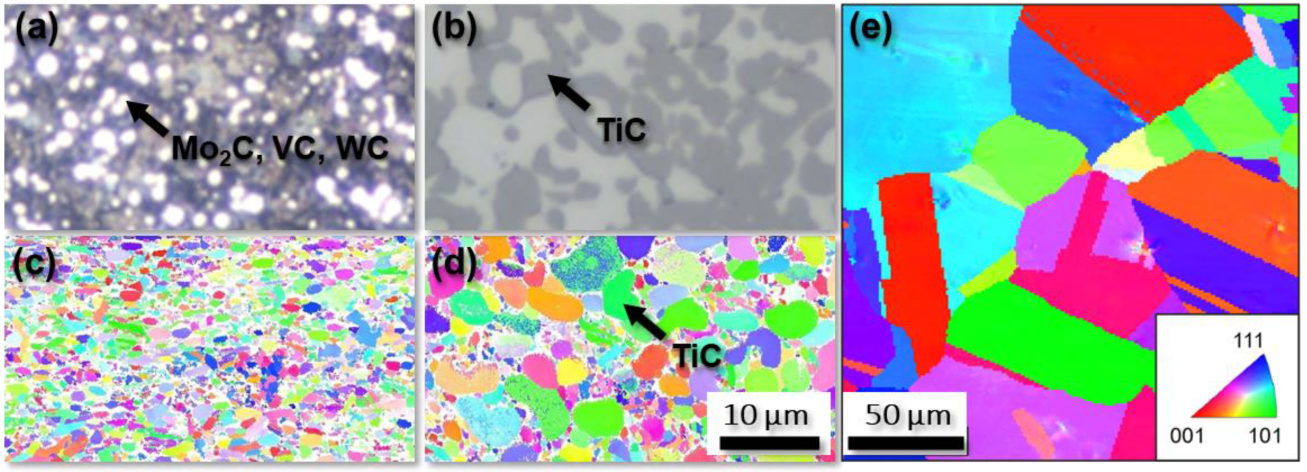
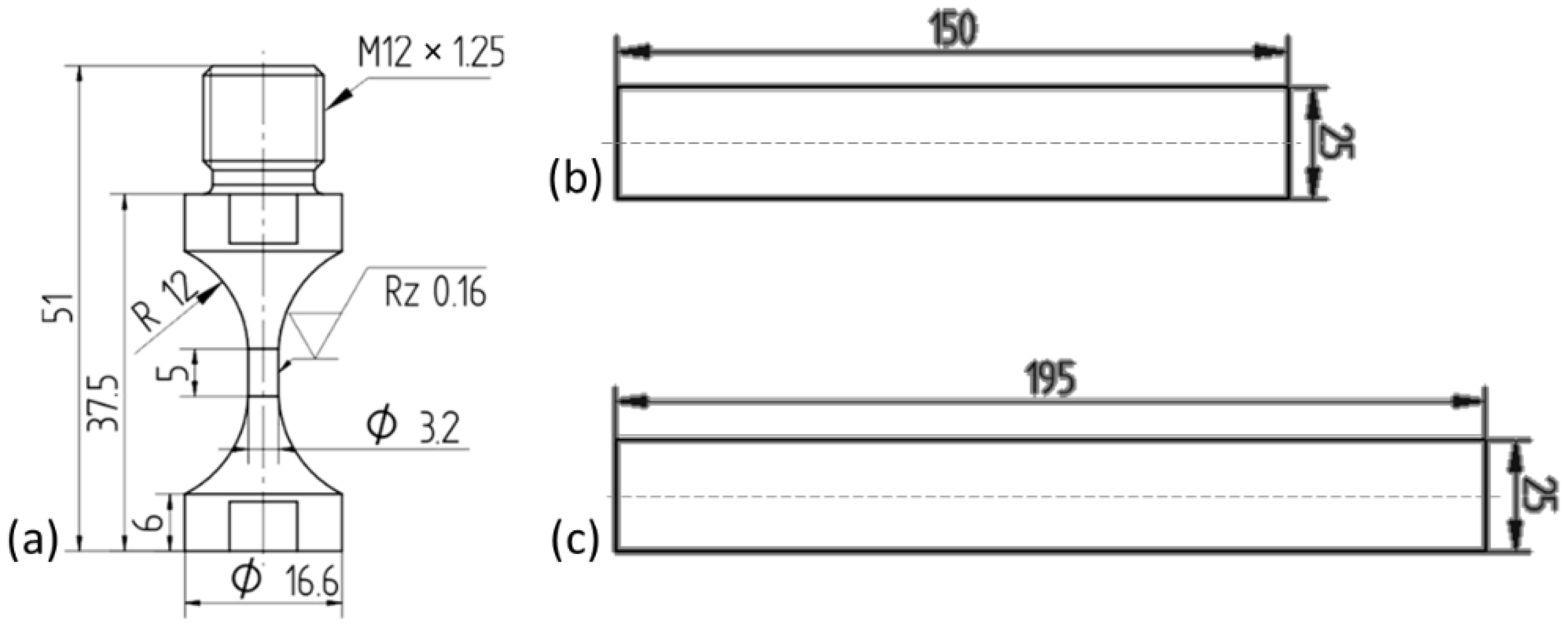
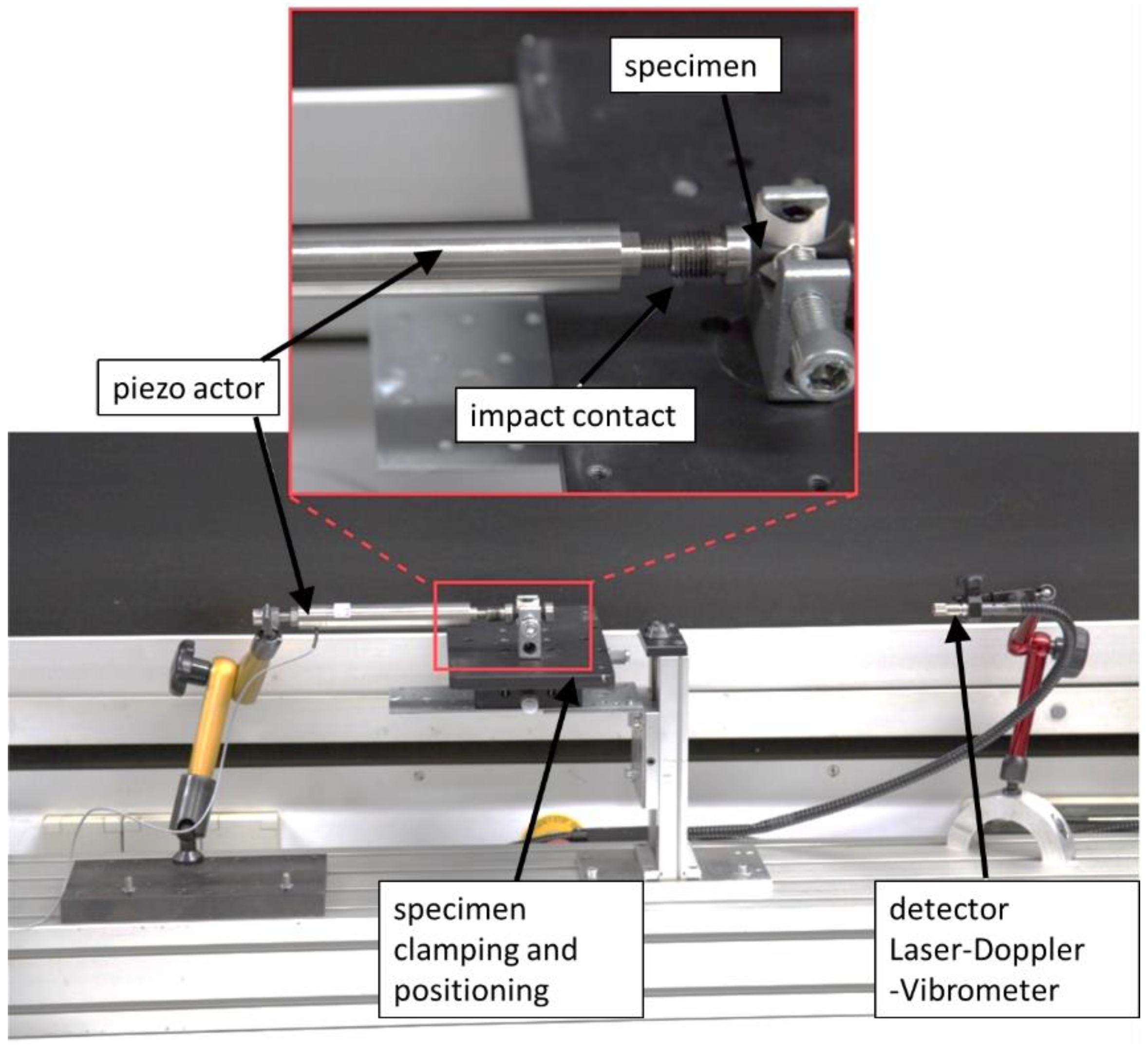

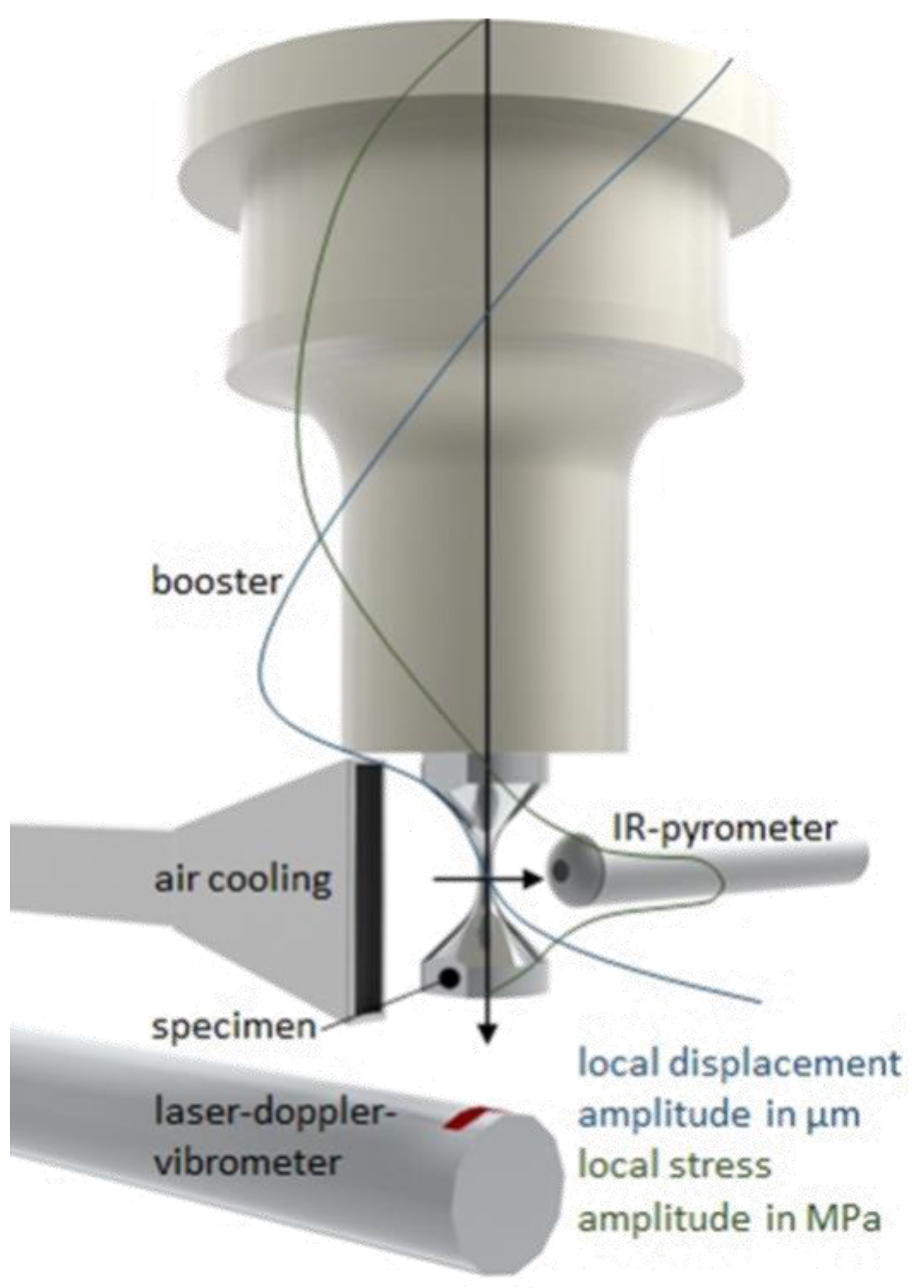

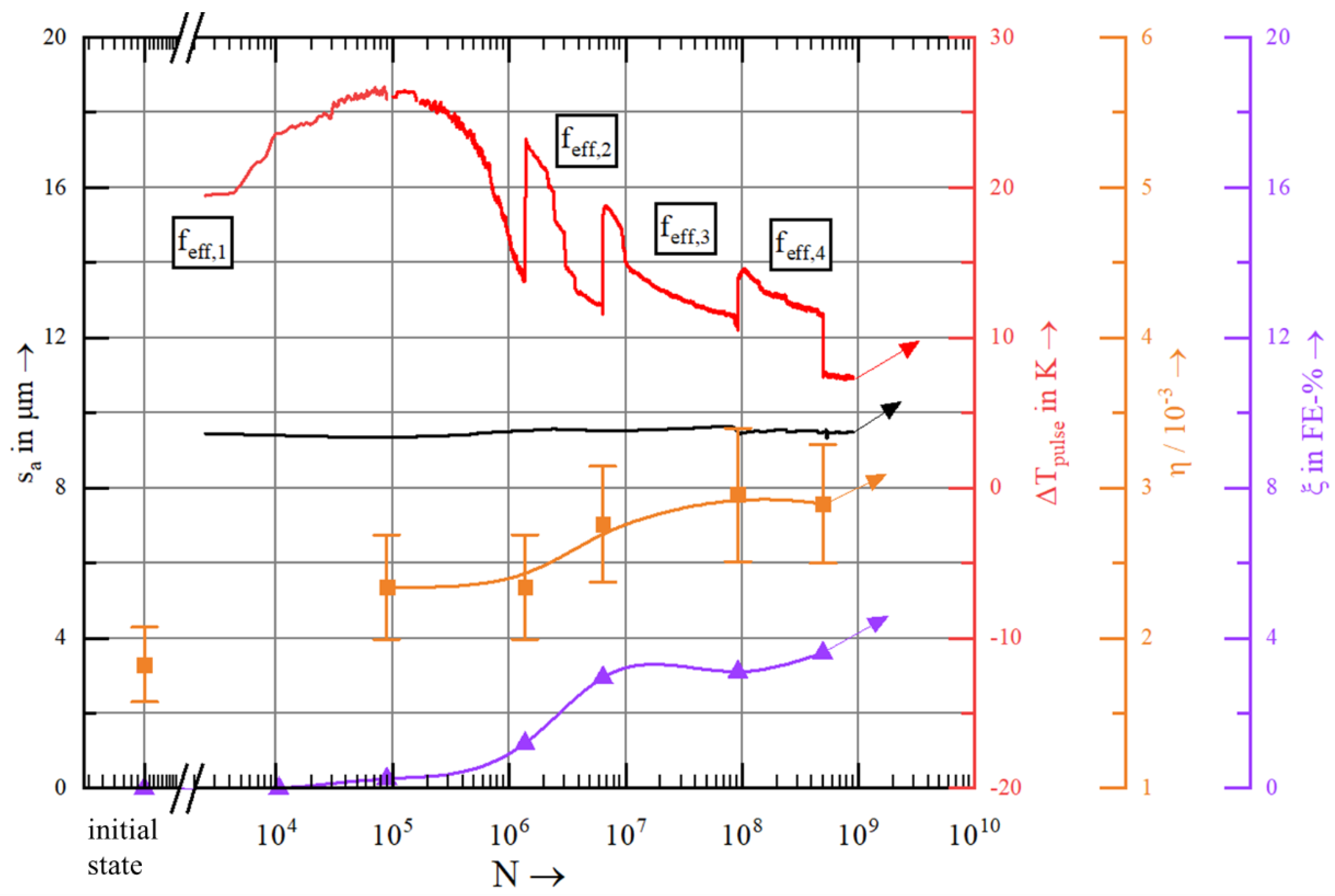

| Material | Pure Copper | Steel AISI 1045 (S45C) | Aluminium Cast Alloy EN AC-42100 | |
|---|---|---|---|---|
| Loading | Tensile | Circumferential bending | Circumferential bending | Tensile & compression |
| Attenuation behaviour | Peak of damping at 20–40% of the lifetime | Sudden peak at 70% of the lifetime | Sudden increase of attenuation | Continuous increase of attenuation until sudden decrease close to the fatigue failure |
| Microstructural reactions | Dislocation movement and formation of slip bands | Interaction of dislocations | Increasing dislocation density & cyclic hardening | Increasing dislocation density & cyclic hardening until saturation followed by crack initiation |
| Source | [8] | [9] | [3] | |
| Fe | C | Mn | Si | Cr | V | Mo | W |
|---|---|---|---|---|---|---|---|
| 79.3% | 1.4% | 0.3% | 0.3% | 4% | 4% | 5.2% | 5.5% |
| Steel Matrix (67%) | Ceramic Phase (33%) | |||
|---|---|---|---|---|
| Fe | C | Cr | Mo | TiC |
| 82.75% | 0.75% | 13.5% | 3.0% | 100% |
| Fe | C | N | Cr | Ni | Mn | Mo | Si | P | Cu | Nb |
|---|---|---|---|---|---|---|---|---|---|---|
| Bal. | 0.04 | 0.007 | 17.60 | 10.64 | 1.83 | 0.29 | 0.41 | 0.02 | 0.06 | 0.62 |
| Z-M4 | WFN | AISI 347 | |
|---|---|---|---|
| Grain size in µm | 1–3 | 0.3–3 | 120 |
| Size of reinforcing phase in µm | 1–2 | 5–8 | - |
| Content of reinforcing phase in area% | 20 | 33 | - |
| Frequency Gradient | Start Frequency | End Frequency | Measurement Time |
|---|---|---|---|
| 1/3 × 105 s−2 | 10 kHz | 40 kHz | 0.9 s |
| Z-M4 | WFN | AISI 347 | |
|---|---|---|---|
| Ee austenite in GPa | 250 ± 5 | 330 ± 7 | 183 [15] |
| Ee thermally induced martensite in GPa | 227 ± 5 | 305 ± 7 | |
| Ee deformation induced α′-martensite in GPa | 175 [25] |
| Z-M4 | WFN | AISI 347 | |
|---|---|---|---|
| ΔEe in GPa | −26 ± 5 | −23 ± 7 | −8 [15,25] |
| ΔEe in % | −12 | −6 | −4 |
| Δf in Hz | −700 | −400 | −100 |
| Δf in % | −3.5 | −2.0 | −0.5 |
| Δfcalc in % according to Equation (4) | −3.5 | −2.4 | −2.0 |
| Δη × 10−4 | −0.3 | −2.8 | +0.6 |
| Δη in % | −57 | −333 | +20 |
Publisher’s Note: MDPI stays neutral with regard to jurisdictional claims in published maps and institutional affiliations. |
© 2022 by the authors. Licensee MDPI, Basel, Switzerland. This article is an open access article distributed under the terms and conditions of the Creative Commons Attribution (CC BY) license (https://creativecommons.org/licenses/by/4.0/).
Share and Cite
Liesegang, M.; Daniel, T.; Jäckels, B.; Smaga, M.; Beck, T. Detection of Microstructural Changes in Metastable AISI 347, HSS Z-M4 and Tool Steel Ferrotitanit WFN by Mechanical Loss Coefficient at Ultrasonic Frequencies. Materials 2022, 15, 6002. https://doi.org/10.3390/ma15176002
Liesegang M, Daniel T, Jäckels B, Smaga M, Beck T. Detection of Microstructural Changes in Metastable AISI 347, HSS Z-M4 and Tool Steel Ferrotitanit WFN by Mechanical Loss Coefficient at Ultrasonic Frequencies. Materials. 2022; 15(17):6002. https://doi.org/10.3390/ma15176002
Chicago/Turabian StyleLiesegang, Moritz, Tobias Daniel, Benedikt Jäckels, Marek Smaga, and Tilmann Beck. 2022. "Detection of Microstructural Changes in Metastable AISI 347, HSS Z-M4 and Tool Steel Ferrotitanit WFN by Mechanical Loss Coefficient at Ultrasonic Frequencies" Materials 15, no. 17: 6002. https://doi.org/10.3390/ma15176002







